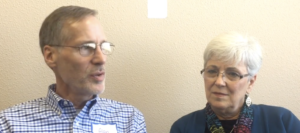Once we move beyond naïve and poorly conceived understandings of how the early church worked (e.g., “They just listened for the leading of the Holy Spirit” … “They decided everything by congregational discussion”), it becomes evident that those first churches were led … by specific people … filling certain roles. Peter. Barnabas. Timothy. Agabus. Philip. John. Paul. Titus.
Then the questions come tumbling: Who made these people church leaders? What were their specific leadership roles? Was leadership in the local congregation singular or communal? What were the responsibilities and duties of different leaders? And how do New Testament roles inform church leadership today?
Such questions address the issue of church governance or polity: “the way a church is organized to do its work” (see prior blog post). Church polity has been one of the most difficult and divisive issues facing the church over the centuries. Wars have been fought over this matter. Churches have split. Shelves of books have been written.
I don’t intend to oversimplify this complex question by appeal to a single passage of Scripture touching on the polity issue. But I do believe that dialogue over church polity can be informed by what Paul says about church leadership in Ephesians 4:11-12:
Now these are the gifts Christ gave to the church: the apostles, the prophets, the evangelists, and the pastors and teachers. Their responsibility is to equip God’s people to do his work and build up the church, the body of Christ. (NLT)
This passage sits squarely in the middle of some “big picture” ideas. The chapter opens with an appeal to worthy living, the call of God, and unity; and an affirmation of the one Lord, one Spirit, one faith (Eph 4:1-6) at the core of the church’s life. Christ is envisioned as the great “gift giver” for his people, the one who “apportions grace” according to his own purposes (Eph 4:7-10). The purpose of Christ’s gifts to the church is clarified here: equipping Christians for ministry, building up the body, maturing people into the fullness of Christ (Eph 4:12-16).
It is in this context that Paul makes mention of specific gifts Christ has given his church. Here (unlike listings of gifts in Rom 12 and 1Cor 12), the gifts are not attributes or abilities but people—apostles, prophets, evangelists, pastors, teachers—who fill certain leadership roles in the church.
That Paul is addressing church leadership in this passage is evident. These are people (or roles) who have been set in place by Christ himself. They have been given critical leadership responsibilities to perform (e.g., equipping, building up, maturing) within the body of Christ. Elsewhere, the New Testament consistently frames these individuals (or roles) as leaders in the early church (see, e.g., 1Cor 12:28).
Let’s do a quick summary of the people/roles mentioned in Ephesians 4:11 … the four (or five) primary leadership positions in the first century church:
- Apostles—witnesses of Jesus’ life, death, and resurrection who were commissioned by Christ and given authority to teach, guide, and organize the emerging church. Certainly the Apostles had wider leadership responsibilities than any one local church—their work transcended geography. But they did exercise considerable authority and influence within local churches (e.g., Peter in Jerusalem; Paul in Corinth and Ephesus; etc.)
- Prophets—Though this role is less understood and appreciated today than the others (at least, within the Churches of Christ), it is apparent that those who had the gift of prophecy exercised a distinct and important form of leadership in the early church. There are thirteen different individuals who are identified with prophetic gifts in Acts. The role of “prophet” is alluded to in several of the epistles (e.g., 1Co 12:28; Eph 4:11). Prophets anointed individuals for special missions (as when Barnabas and Paul were sent out as missionaries—Ac 13:1-3); warned the church about impending events and urged action (as when Agabus foretold of famine—Ac 11:27-30); served as spokesmen for churches (as did Judas and Silas for Jerusalem—Ac 15:27, 32); and spoke regularly to the church in public assemblies (1Co 14:29).
- Evangelists—people who were gifted and called to preach the good news of Christ. Whether inside or outside the church, evangelists spoke a message founded in the story and teachings of Jesus, not in direct revelation (as, presumably, did the prophets). In some ways, first century evangelists seemed to function in ways similar to modern missionaries: making converts, founding local congregations, and nurturing immature Christians (the kind of work that “Philip the Evangelist” seemed to have done among the Samaritans—Ac 8). In other ways, however, early evangelists functioned more like modern pulpit ministers, directing their attentions to the needs of a local congregation, and exercising within the church a direct leadership role. Paul’s letters to Timothy (written by the Apostle to give instructions about doing “the work of an evangelist”—2Ti 4:5) imply that teaching and preaching, mentoring and maturing, ordering public worship, selecting elders, and organizing church ministries were among the “duties” that accompanied the work of an evangelist
- Pastors (Shepherds)—men who were acknowledged as mature and wise and asked to serve as the spiritual mentors of a congregation. In the New Testament church, the term “shepherd” appears to be synonymous with “overseer” and “elder.” (See Acts 20:28 where Paul addresses the elders of Ephesus and urges them to be “shepherds” and “overseers” of the church.) Wherever possible, pastors were appointed for each local church and served the church through teaching, spiritual counsel, supervision, management, and care of God’s people. This role seems to have involved shared responsibilities, in that—while pastors functioned individually to care for church members—they also worked with other pastors/shepherds in exercising a formal leadership role in the local congregation.
- Teachers—[I am familiar with the argument (based on the grammar of this verse) that the last two “giftings” listed in Eph 4:11 refer to a combination role (the “teaching pastors”) rather than two distinct roles (“pastors” and “teachers”). For the sake of this discussion, I will consider these as distinct roles.] “Teacher” is one of Jesus’ favorite self-designations and a term used of him by friend and foe alike. The term acknowledged not only his knowledge and wisdom regarding the Scriptures, but his commitment to gathering a group of disciples (his “school”), interpreting and applying Scripture, and instructing in both private and public settings. In the early church, this teaching function continued. The gift of teaching is identified in Ro 12:7. The role of “Teacher” is mentioned in Ac 13:1 (“Now in the church at Antioch there were prophets and teachers”) and 1Co 12:28 (“God has placed in the church first of all apostles, second prophets, third teachers”) in a way that implies a position of influence and authority. Several individuals are identified as “Teacher” within the early church (see, for example, Ac 13:1; 1Ti 2:7). To the degree that Christ himself is the model of this “teaching” function (and if those who had the gift of teaching were to use that gift in Christ-like ways), then “Teacher” must have involved an instructional ministry rooted in Scripture, focused on mentoring disciples, including both public and private instruction, and accompanied—like the teaching ministry of Jesus—by an aura of “authority” (see Mk 1:22).
Even though Paul is probably speaking in this passage of church leadership for the church generally (as opposed to the structure of leadership in a local congregation), the model for governance he mentions here can be summarized as:
We tend to focus on the people/roles Paul mentions here, attempting to identify various leadership positions … “nodes of spiritual authority” within the church. But what I find truly interesting about the above model has little to do with specific people/roles and much more to do with some fundamental dynamics implied by this organizational model … dynamics that may well transcend the particular leadership “positions” listed.


